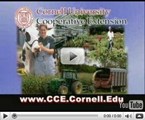Late Blight was confirmed on both tomatoes and potatoes on July 27, 2010. Grown in a home garden in the city, the sample was collected on July 25 after the entire crop of tomatoes died almost overnight. Nearby potatoes are also infected.
In an effort to avoid the catastrophe that happened last year, gardeners are asked to please monitor tomatoes and potatoes in earnest. Look for dark watery lesions on the leaves, stems and fruit. Late blight spreads quickly. Cornell recommends “If late blight becomes severe, remove diseased plants by digging them up. Destroy these plants immediately by one of the following: burying them deeply in an area away from the garden, burning them, or by bagging them in a plastic bag and discarding the bag. These steps will help avoid production of a larger number of spores. Harvest all potato tubers in the garden. If late blight occurs when the tubers have already 'sized up', harvest the crop as soon as possible to avoid post-harvest tuber rot. Again, destroy diseased foliage and stems.”
There are fungicides that can be sprayed to prevent infection, but once severe infection has taken hold, chemical controls will not work. Commercial growers should check http://www.nysaes.cornell.edu/recommends/ for the latest pesticide recommendations.
Home gardeners can follow these recommendations if diagnosis is confirmed: use azoxystrobin (not near apples), Bacillus subtilis, chlorothalonil, copper soap (copper octanoate), or copper sulfate. Protectant fungicides (chlorothalonil or copper products) should be used at first appearance of disease according to the label instructions.
The fungus that causes late blight has become a major threat to home gardens and commercial growers because of the migration of new strains (genotypes) into the United States. Verification of a late blight diagnosis and implementation of prompt control measures are highly recommended. The newly arrived strains are more aggressive than previous strains.
Current information about late blight and its management can be found at http://blogs.cornell.edu/lateblight/ and great webinars on late blight for home organic gardens and organic farms can be found at http://www.extension.org/article/24989. Details on submitting a sample to the Cornell Plant Disease Diagnostic Clinic can be found at http://plantclinic.cornell.edu/. Cornell Cooperative Extension Capital District Vegetable & Small Fruit Specialists, who work primarily with commercial growers, are available to assist with diagnosis and recommendations: Chuck Bornt 518-272-4210, Laura McDermott 518-746-2562 and Crystal Stewart 518-775-0018.




